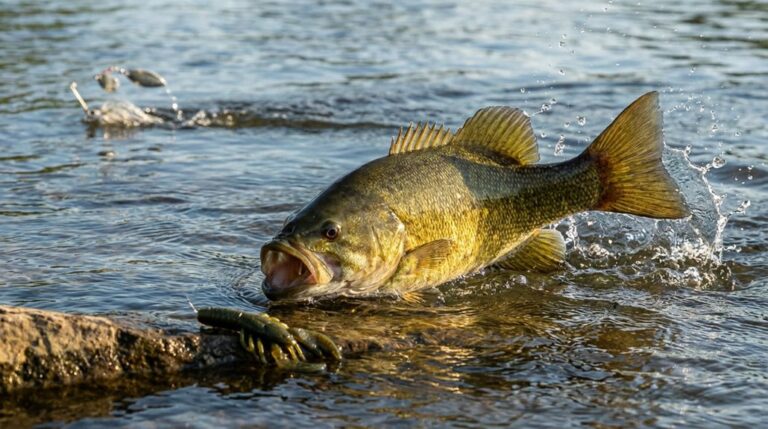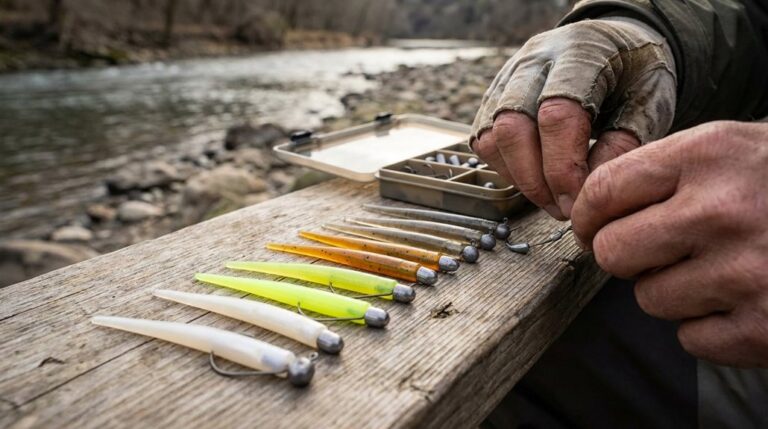To start topwater bass fishing, choose the right lure for your conditions and master the walk-the-dog technique. Time your casts for early morning or late evening, and vary your retrieval speed to mimic prey. Pay attention to water conditions and target structure like fallen trees. When a bass strikes, wait to feel its weight before setting the hook. Listen for feeding activity to locate prime spots. Use appropriate gear, including a medium-heavy rod and 12-20 pound test line. Above all, practice patience and persistence. With these tips, you'll be well on your way to landing your first topwater bass. The excitement of that surface strike is worth the effort.
Choose the Right Topwater Lure

Anglers know that selecting the right topwater lure is crucial for success. When choosing your lure, consider these factors:
- Water conditions
- Bass species
- Time of day
- Weather
Popular topwater lures include:
- Poppers: Great for calm waters, creating a "pop" sound to attract bass.
- Buzzbaits: Ideal for covering large areas quickly, they create a commotion on the surface.
- Walking baits: These zigzag across the water, mimicking wounded prey.
- Prop baits: Equipped with propellers, they're perfect for still waters.
For beginners, start with a popper or buzzbait. They're easier to work and highly effective. Realistic movement and noise generation are key features that enhance fish attraction, mimicking natural prey behavior. Weedless designs allow fishing in diverse environments without snagging, expanding your options. Remember, matching your lure to the conditions and your target species will greatly increase your chances of landing that trophy bass. Don't be afraid to experiment with different lures to find what works best for you.
Time Your Casts Strategically
During topwater bass fishing, timing your casts strategically can make a significant difference in your success rate. You'll want to focus on prime feeding times and locations to maximize your chances of landing a big one. Night fishing can be particularly effective, especially during warmer months when bass are more active after dark.
- Early Morning and Late Evening: Bass are most active during low-light conditions.
- Overcast Days: Cloud cover can extend feeding periods throughout the day.
- Near Cover: Cast close to structures like fallen trees, lily pads, or dock edges.
Pay attention to surface activity, such as ripples or splashes, which can indicate feeding bass. When you spot these signs, cast your lure just beyond the disturbance and work it back through the area. Remember, patience is key – don't be afraid to let your lure sit motionless for a few moments, as this can trigger a strike from curious bass.
Master the Walk-the-Dog Technique
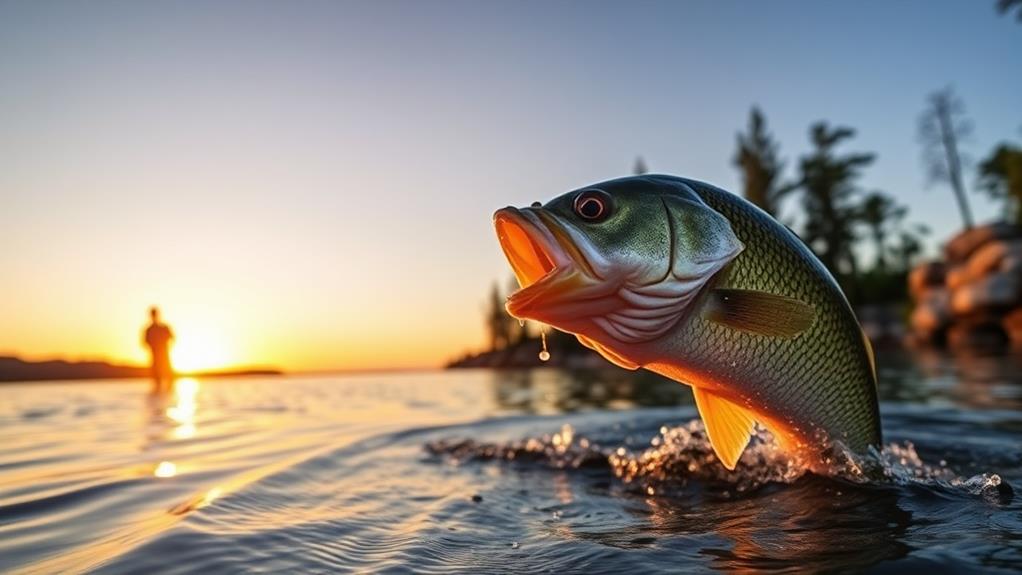
One of the most effective techniques for topwater bass fishing is the "walk-the-dog" method. This technique involves moving your rod tip in a rhythmic, side-to-side motion, causing your lure to zigzag across the water's surface. To master this technique, start with small, controlled movements and gradually increase the intensity as you become more comfortable. The Heddon Zara Spook is an excellent lure for practicing this technique, known for its effectiveness and high user ratings.
Here are three key tips to help you perfect the walk-the-dog technique:
- Keep your rod tip low and parallel to the water
- Use your wrist, not your arm, for precise movements
- Maintain a steady retrieve speed
As you practice, you'll develop a feel for the right cadence and rhythm. Remember, the goal is to mimic the movement of a wounded baitfish, enticing bass to strike. With patience and persistence, you'll soon be walking the dog like a pro, reeling in those trophy bass.
Vary Your Retrieval Speed
Varying your retrieval speed is a crucial skill for successful topwater bass fishing. It's all about keeping those bass guessing! By changing up your pace, you'll mimic the erratic movements of prey and trigger more strikes. Topwater lures are especially effective during warm months when bass are more likely to strike aggressively at the surface.
Try these retrieval techniques:
- Slow and steady: Perfect for calm waters
- Quick bursts: Imitate fleeing baitfish
- Stop-and-go: Create the illusion of an injured prey
Remember, there's no one-size-fits-all approach. Pay attention to how the bass react and adjust accordingly. On hot days, a slower retrieve might be more effective, while a faster pace could work wonders during feeding frenzies.
Don't be afraid to experiment! Sometimes, an unexpected change in speed can entice even the most stubborn bass. Keep your retrieves unpredictable, and you'll be reeling in more fish in no time. After all, fishing's all about adapting and outsmarting your prey.
Pay Attention to Water Conditions

While mastering retrieval techniques is important, successful topwater bass fishing also hinges on reading water conditions. Pay attention to factors like water temperature, clarity, and surface activity. These elements can greatly influence bass behavior and their willingness to strike topwater lures.
When you're on the water, keep these points in mind:
- Calm, glassy surfaces often require more subtle presentations
- Choppy water can mask your lure's presence, allowing for more aggressive retrieves
- Cloudy days may extend topwater fishing opportunities throughout the day
In cooler temperatures, bass tend to be less active near the surface, so you'll need to slow down your retrieval. On warm, sunny days, focus on shaded areas where bass might be seeking refuge. By adapting your approach to match the conditions, you'll increase your chances of enticing those trophy bass to strike.
Target Structure and Cover
For successful topwater bass fishing, you'll want to focus on structure and cover. Bass love to hang out near underwater obstacles, so cast your lure near fallen trees, docks, lily pads, and weed beds. These areas provide shelter and ambush points for bass, making them prime spots for topwater action.
Remember, bass are opportunistic predators. They'll often lurk in the shadows, waiting to strike unsuspecting prey. That's where your topwater lure comes in handy. Work it around these structures, mimicking a struggling baitfish or insect. The commotion on the surface will attract nearby bass, triggering their predatory instincts.
Don't be afraid to get close to cover. Sometimes, the best strikes come when you're practically bumping your lure against a log or dock piling. Just be ready to set the hook and steer that bass away from potential snags!
Set the Hook Properly
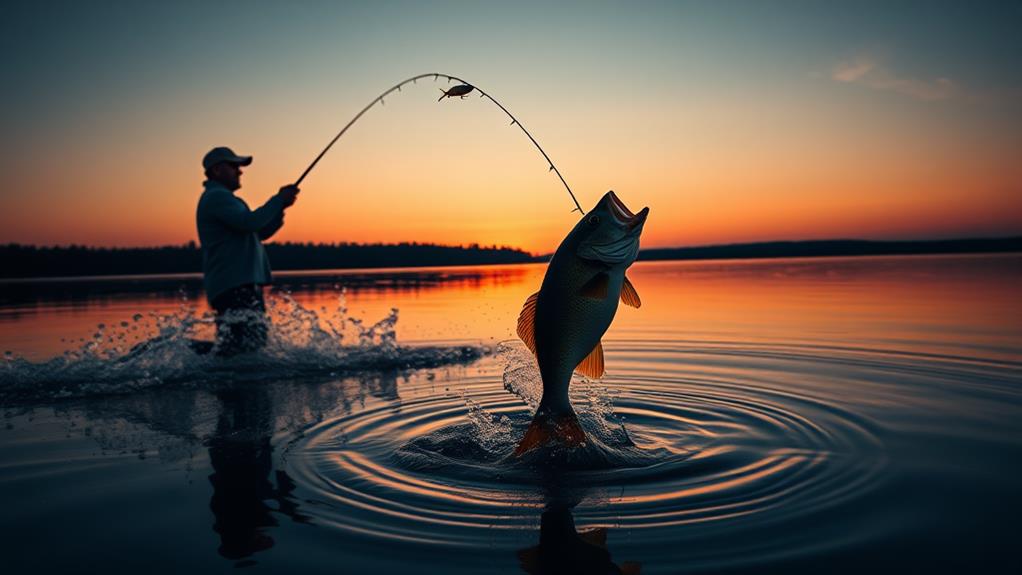
When it comes to setting the hook, timing is everything in topwater bass fishing. You'll want to resist the urge to jerk the rod at the first sign of a strike. Instead, wait until you feel the weight of the fish before setting the hook. This pause allows the bass to fully engulf your lure, increasing your chances of a solid hookset.
To master the art of setting the hook, keep these tips in mind:
- Watch your line, not just the lure, for subtle movements
- Listen for the distinctive "slurp" sound of a bass strike
- Feel for the tension in your line before reacting
Listen for Feeding Activity
How can you increase your chances of success when topwater bass fishing? One of the most effective strategies is to listen for feeding activity. Bass are opportunistic predators, and they often make a commotion when chasing prey near the surface. Keep your ears open for splashing, popping, or slurping sounds that indicate bass are actively feeding.
These noises can guide you to prime fishing spots, where bass are more likely to strike your lure. Pay attention to the early morning and late evening hours, as these are typically the most active feeding times for bass. Don't be afraid to move around the lake or pond, following the sounds of feeding activity. By tuning into these auditory cues, you'll be able to target areas where bass are actively hunting, increasing your chances of a successful catch.
Use Appropriate Gear
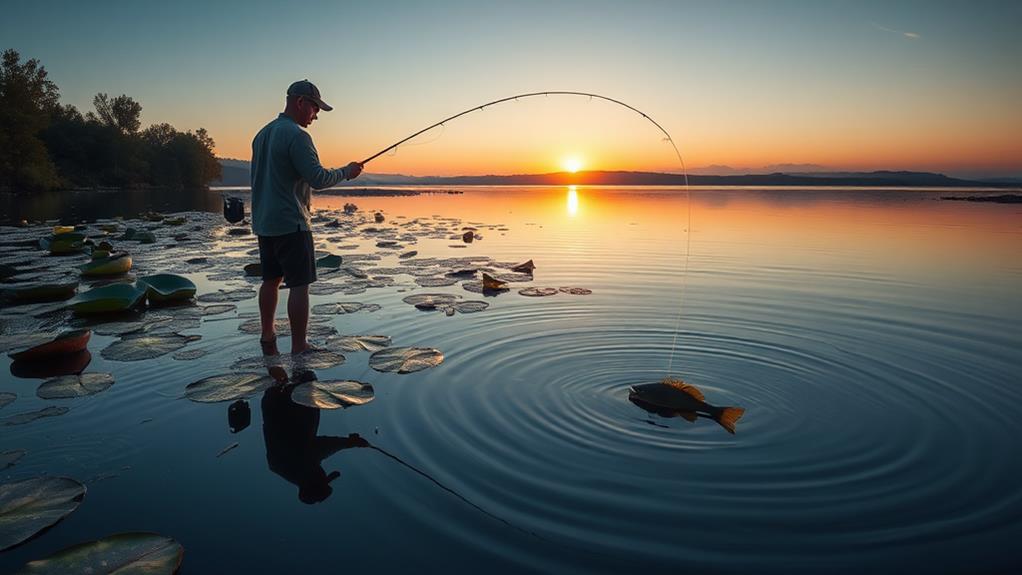
Selecting the right gear is crucial for successful topwater bass fishing. You'll want a medium-heavy rod with a fast action tip, paired with a baitcasting reel spooled with 12-20 pound test line. This setup gives you the power to cast accurately and set the hook firmly. Choose lures that mimic the local forage, such as poppers, walking baits, or buzzbaits.
To make the most of your topwater fishing experience:
- Feel the rush of adrenaline as you watch a bass explode on your lure
- Embrace the freedom of casting into open water, unencumbered by vegetation
- Experience the satisfaction of mastering a challenging technique
Practice Patience and Persistence
Mastering topwater bass fishing calls for unwavering patience and persistence. You'll often find yourself casting repeatedly without a bite, but don't get discouraged. Remember, bass can be finicky creatures, and their moods change throughout the day.
- Stay focused: Keep your eyes on the lure and be ready for sudden strikes.
- Vary your retrieve: Experiment with different speeds and pauses to entice stubborn fish.
- Trust your instincts: If you believe bass are present, keep working the area.
Don't give up if you're not getting bites right away. Sometimes, it takes a while for bass to become active or curious about your lure. Stick with it, and you'll increase your chances of landing that trophy fish. After all, the thrill of a topwater strike is worth the wait!
Frequently Asked Questions
How Do I Store and Maintain My Topwater Lures?
To keep your topwater lures in top shape, follow these simple steps:
- Clean them after each use with fresh water
- Dry thoroughly to prevent rust
- Store in a tackle box with compartments to avoid tangling
- Replace hooks as needed to maintain sharpness
- Keep lures away from direct sunlight to prevent color fading
- Use lure conditioner on wooden lures to prevent cracking
Can I Use Topwater Lures in Saltwater Fishing?
Yes, you can absolutely use topwater lures in saltwater fishing! They're great for targeting species like striped bass, redfish, and snook. Just be sure to rinse your lures thoroughly with freshwater after each use to prevent corrosion. Saltwater-specific topwater lures are often made with more durable materials and stronger hardware to withstand the harsh environment. Remember, saltwater fish can be more aggressive, so be prepared for some exciting strikes! Adjust your technique based on the species you're targeting and local conditions.
What's the Best Line Type for Topwater Fishing?
For topwater fishing, you'll want to use monofilament or braided line. Mono's a great all-around choice, offering good buoyancy and a bit of stretch for those explosive strikes. Braided line, on the other hand, gives you excellent sensitivity and strength. It's perfect when you're dealing with heavy cover or need long casts. Whichever you choose, aim for 10-20 lb test strength. Remember, the right line can make all the difference in landing that trophy fish!
How Do I Prevent Backlash When Casting Topwater Lures?
To prevent backlash when casting topwater lures, you'll want to master a few key techniques. First, adjust your reel's brakes and tension knob properly. Practice your casting technique, using a smooth, controlled motion. Don't whip the rod too hard; let the lure's weight do the work. As you release, use your thumb to feather the spool, applying light pressure. If you feel the line slowing, increase thumb pressure. With practice, you'll develop a feel for it. Remember, even pros get the occasional backlash!
Are There Specific Colors of Topwater Lures for Different Conditions?
Yes, there are specific colors of topwater lures for different conditions. You'll want to match your lure's color to the lighting and water clarity:
- Bright days, clear water: Use natural, subtle colors like blue, green, or silver.
- Overcast days, stained water: Opt for brighter colors like white, chartreuse, or yellow.
- Low light or night fishing: Try dark colors like black or purple.


